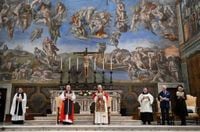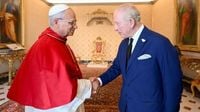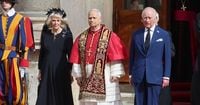For the first time in five centuries, the head of the British monarchy and the pope prayed side by side, marking a moment of profound significance for both the Church of England and the Roman Catholic Church. On October 23, 2025, King Charles III and Queen Camilla joined Pope Leo XIV in the Sistine Chapel for an ecumenical service that many observers have called historic—a gesture of unity that echoed through the marble halls of the Vatican and resonated far beyond.
The service, held beneath Michelangelo’s iconic ceiling, brought together the spiritual leaders of two Christian traditions that have been divided since King Henry VIII’s break with Rome in 1534. According to The Associated Press, this was the first time since the Reformation that the heads of the Church of England and the Catholic Church had prayed together publicly. The moment was imbued with symbolism, from the golden thrones on the altar to the music—hymns performed by the Sistine Chapel choir and visiting members of two royal choirs: St. George’s Chapel choir of Windsor Castle and the children’s choir of the Chapel Royal of St. James’s Palace.
As reported by CNN, the musical selection included Thomas Tallis’s "If ye love me," a piece whose composer’s life spanned the tumultuous period of the Reformation. Tallis, known for his sacred choral works, managed to maintain his Catholic faith even as he thrived under the new Anglican establishment. The choice of music underscored the continuity of faith despite centuries of division.
The ecumenical service was presided over by both Pope Leo XIV and the Archbishop of York, Stephen Cottrell, who represented the Church of England in place of Sarah Mullally, the newly elected first female archbishop of Canterbury. Mullally was not yet formally installed as the Church’s spiritual leader, so Cottrell took her place at this unprecedented gathering. The congregation included senior clergy and cardinals, with the Foreign Secretary, Yvette Cooper, delivering a reading from the Letter to the Romans, dressed in traditional black attire for women meeting the pope, as reported by The Independent.
During the service, Pope Leo led the prayer: "Let us pray. God our Father, you have created the heavens and the earth and made us in your own image: teach us to see your hand in all your works and your likeness in all your children. Through Christ our Lord." The congregation responded in unison, "Amen." In another powerful gesture of unity, the pope and Archbishop Cottrell together intoned, "The grace of our Lord Jesus Christ, and the love of God, and the fellowship of the Holy Spirit, be with us all evermore," to which the congregation again replied, "Amen."
The royal couple’s visit to the Vatican was not just about spiritual symbolism. It came at a turbulent time for the British royal family, which was facing renewed scrutiny over sexual misconduct allegations against Prince Andrew. The prince, dogged by accusations linked to convicted sex offender Jeffrey Epstein, had announced he would cease using his titles, including Duke of York, though he continued to deny the claims. As AP noted, the visit offered King Charles and Queen Camilla a welcome respite from the turmoil at home, providing a moment of spiritual reflection and diplomatic engagement.
The significance of the visit was heightened by its timing. Originally planned for earlier in 2025, the trip was postponed due to the illness and subsequent death of Pope Francis. Charles and Camilla had managed a private visit with the ailing pontiff shortly before his passing. The Vatican and the British monarchy have enjoyed full diplomatic relations only since 1982, but warm ties have developed over recent decades, with Queen Elizabeth II meeting five popes and Charles visiting Vatican City five times as Prince of Wales.
Upon their arrival in Rome, the King and Queen met Pope Leo XIV for the first time since his election in May 2025. The ceremonial welcome included a guard of honour from the Vatican’s famed Swiss Guard, and the exchange of gifts: Charles presented the pope with a large silver photograph and an icon of St. Edward the Confessor, while Pope Leo reciprocated with a scale mosaic of Christ Pantocrator from the Norman Cathedral of Cefalù in Sicily. Discussions between the two leaders, as reported by CNN and The Independent, were described as cordial and focused on shared concerns such as environmental protection, poverty alleviation, and the promotion of peace and security amid global challenges.
Later that day, the royal couple attended an ecumenical service at the Basilica of St. Paul’s Outside the Walls, a site with deep historical ties to the English Crown. Here, King Charles was formally recognized as "Royal Confrater" of the basilica, a gesture of hospitality and spiritual fellowship. In return, Charles named Pope Leo as "Papal Confrater of St. George’s Chapel, Windsor Castle" and awarded him the Knight Grand Cross of the Order of the Bath, a high honour traditionally reserved for heads of state. The pope, in turn, made Charles and Camilla a knight and dame of the Order of Pius IX. A special throne-like chair, adorned with the King’s coat of arms and the Latin motto "Ut unum sint" ("That they may be one"), was commissioned for Charles and will remain at the basilica for his use and that of his heirs.
The visit was capped by a reception at the Pontifical Beda College, where Charles met seminarians from across the Commonwealth. Queen Camilla, meanwhile, met with six Catholic sisters from the International Union of Superiors General, who are engaged in supporting female empowerment and girls’ education globally.
Despite the ceremony and goodwill, the visit unfolded against a backdrop of tension within the Anglican Communion. The recent election of Sarah Mullally as the first female archbishop of Canterbury has exacerbated longstanding divisions. The Global Fellowship of Confessing Anglicans (Gafcon), a conservative group representing a majority of the Anglican Communion’s membership, announced its intention to reject traditional bureaucratic ties and criticized both the Church of England’s LGBTQ-affirming stances and the appointment of a woman to the Church’s highest office. Gafcon’s leaders argue that such moves undermine the unity and identity of global Anglicanism, especially among its African members.
Yet, as Rev. Martin Browne from the Vatican’s department for Promoting Christian Unity told CNN, "It would be difficult to overstate the significance of this particular visit." He emphasized that, despite deep differences, the act of praying together in the Sistine Chapel was a powerful reminder of the bonds that unite Christians. Church historian Diarmaid MacCulloch echoed this sentiment, noting, "There is some genuine significance in the Papacy showing such formal favor to Charles. It’s a nice goodwill gesture on the Vatican’s part, and goodwill gestures are always welcome."
This historic state visit, blending pageantry with earnest ecumenical outreach, has set a new precedent for relations between the British monarchy and the papacy. While divisions remain, the shared prayers and gestures of fellowship in Rome may well serve as a turning point, encouraging further dialogue and cooperation between two of the world’s oldest Christian traditions.


